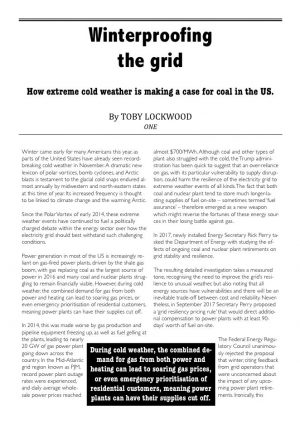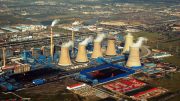 Winter came early for many Americans this year, as parts of the United States have already seen record-breaking cold weather in November. A dramatic new lexicon of polar vortices, bomb cyclones, and Arctic blasts is testament to the glacial cold snaps endured almost annually by midwestern and north-eastern states at this time of year. Their increased frequency is thought to be linked to climate change and the warming Arctic.
Winter came early for many Americans this year, as parts of the United States have already seen record-breaking cold weather in November. A dramatic new lexicon of polar vortices, bomb cyclones, and Arctic blasts is testament to the glacial cold snaps endured almost annually by midwestern and north-eastern states at this time of year. Their increased frequency is thought to be linked to climate change and the warming Arctic.
Since the Polar Vortex of early 2014, these extreme weather events have continued to fuel a politically charged debate within the energy sector over how the electricity grid should best withstand such challenging conditions.
Power generation in most of the US is increasingly reliant on gas-fired power plants, driven by the shale gas boom, with gas replacing coal as the largest source of power in 2016 and many coal and nuclear plants struggling to remain financially viable. However, during cold weather, the combined demand for gas from both power and heating can lead to soaring gas prices, or even emergency prioritisation of residential customers, meaning power plants can have their supplies cut off.
In 2014, this was made worse by gas production and pipeline equipment freezing up, as well as fuel gelling at the plants, leading to nearly 20 GW of gas power plant going down across the country. In the Mid-Atlantic grid region known as PJM, record power plant outage rates were experienced, and daily average wholesale power prices reached almost $700/MWh. Although coal and other types of plant also struggled with the cold, the Trump administration has been quick to suggest that an over-reliance on gas, with its particular vulnerability to supply disruption, could harm the resilience of the electricity grid to extreme weather events of all kinds. The fact that both coal and nuclear plant tend to store much longer-lasting supplies of fuel on-site – sometimes termed ‘fuel assurance’ – therefore emerged as a new weapon which might reverse the fortunes of these energy sources in their losing battle against gas.
In 2017, newly installed Energy Secretary Rick Perry tasked the Department of Energy with studying the effects of ongoing coal and nuclear plant retirements on grid stability and resilience.
The resulting detailed investigation takes a measured tone, recognising the need to improve the grid’s resilience to unusual weather, but also noting that all energy sources have vulnerabilities and there will be an inevitable trade-off between cost and reliability. Nevertheless, in September 2017 Secretary Perry proposed a ‘grid resiliency pricing rule’ that would direct additional compensation to power plants with at least 90-days’ worth of fuel on-site.
The Federal Energy Regulatory Council unanimously rejected the proposal that winter, citing feedback from grid operators that were unconcerned about the impact of any upcoming power plant retirements. Ironically, this decision took place while a 13-day cold snap – known as the Bomb Cyclone – was sweeping the country, reigniting the issue just as soon as it might have been laid to rest.
In response to the Polar Vortex, several grid operators in the North-East had already introduced changes to their ‘capacity markets’, which are well-established mechanisms to pay certain power plants for simply being available, whether they generate or not.
Given that many plants failed to fulfil these obligations during the 2014 event, the action was taken to pay generators more when they could perform well and penalise them more harshly if they were unavailable when needed, with regular checks imposed. In PJM, plants were increasingly required to demonstrate the dependability of their fuel supply in the form of long-term gas contracts or the ability to switch to oil if necessary.
In New England, the grid operator introduced a temporary Winter Reliability Program, which paid generators for storing oil and gas, before making permanent changes to its capacity market in 2018. The Bomb Cyclone in the winter of 2017-2018 was the first real test of these new measures. Although neither the cold nor electricity demand quite reached the levels seen in 2014, the long duration of the cold snap put the grid under considerable strain. PJM declared its market changes a success, with a much lower proportion of power plants put out of action (8% of capacity), and nearly half as many gas plants suffering from supply issues. Although gas prices actually went much higher in 2018 than they had during the Polar Vortex, electricity prices did not reach the same dizzy heights.
Despite this confident outlook, a study of the grid’s response to the Bomb Cyclone by the Department of Energy’s National Energy Technology Laboratory (NETL) found that normally little-used coal plant had been vital to meeting the growth in power demand, providing over half of the additional generation required across the eastern grids compared to an average winter day. Their analysis concluded that ongoing coal plant retirements, combined with inadequate investment in new gas pipeline capacity in these regions put some grids at risk of blackouts in future.
A war of words developed, as PJM shot back with its own response, maintaining that plenty of spare gas power plants were available and their losing out to coal plant during the cold was simply a result of the energy market functioning as usual. The NETL was quick to point out that these claims seemed at odds with PJM’s own president’s statements on the event, which agreed that they could not have served customers without their coal-fired plant and that fuel security risks were a growing concern for the operator.
In a formal reply, the government lab held that the high gas prices actually underlaid a genuine gas shortage in parts of the grid, with pipelines hugely over-subscribed by the time they reach the East Coast. To all intents and purposes, they claimed, a far higher proportion of gas plants were unable to generate.
In January 2019, the Polar Vortex returned, this time bringing record cold temperatures to the Midwest in particular, and again resurrecting the grid resilience debate.
Thousands of customers in Wisconsin and Iowa went without power, as the region’s electricity system operator (MISO) suffered the loss of generation from around 25% of its generators and prices spiked to $800/MWh. However, the response to the emergency was generally regarded as a success, avoiding widespread blackouts. In PJM, where the cold was less severe, some commentators have noted that similar numbers of coal and gas plant were put out of action, although a further 3 GW of gas plant once again ran short of gas. There appears to be little prospect of a return of the kind of direct support for coal and nuclear plants originally proposed by Secretary Perry (who has since left the administration).
Still, concerns remain over how to manage the ever-growing relationship between the gas and electricity grids. Advocates of renewable energy argue that these sources can strengthen the system, together with smarter grids which have greater flexibility for consumers to reduce their demand. However, wind power – the renewable of choice for most US states – has often shown poor performance during cold weather events like the Bomb Cyclone.
Expansion of the gas grid could prove to be the most realistic insurance policy, but that will take time. Meanwhile, it remains to be seen if and when the grid will begin to really feel the effects of the ongoing wave of coal plant retirements throughout the country. With colder temperatures forecast to return later this winter, another chapter in this saga may soon be written.
Toby Lockwood





